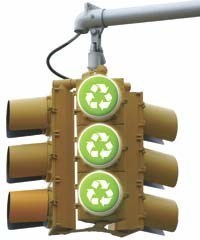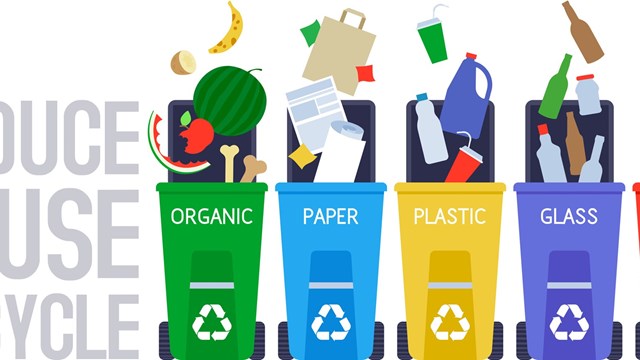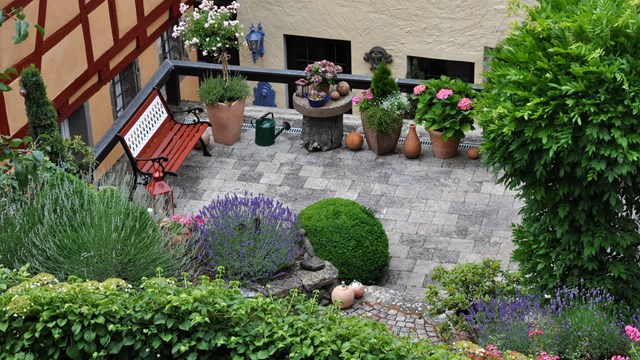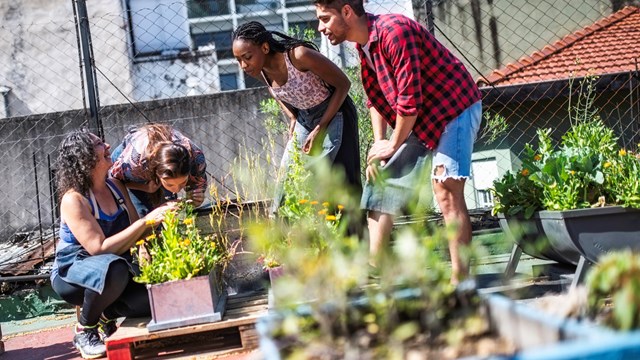
Green truly is the new black in New England. As more and more condos and HOAs look to save money as expenses rise, more and more boards and unit owners are exploring ways to incorporate “greening” into their building community.
Green homes are expected to grow between 29 percent to 38 percent of the residential construction market by the year 2016, which is equal to $87 billion to $114 billion of that market, according to a 2012 McGraw Hill Construction study.
According to the U.S. Green Building Council, whose Leadership in Energy and Environmental Design program is the gold standard, the residential market—from multi- to single-family, from market rate to affordable housing, is reaping the benefits of using green building techniques. Since the launch of LEED for Homes in 2008, more than 30,000 homes have received LEED for Homes certification and nearly 93,000 are registered for certification. Over half of all LEED-certified homes are in the affordable housing category, the USGBC says.
According to the USGBC, in the United States alone, buildings account for: 65% of electricity consumption, 36% of energy use, 30% of greenhouse gas emissions, 30% of raw materials use, 30% of waste output (136 million tons annually), and 12% of potable water consumption. Not only do green buildings enhance and protect ecosystems and biodiversity, improve air and water quality, but they reduce solid waste and reduce operating costs as well. Additionally, living in a green building is more comfortable and healthier and more satisfying for residents, and going green optimizes the life-cycle performance of a building’s operating systems and its infrastructure. The air, thermal heating and acoustical environments in the building are also improved.
An Emerging Trend
Instead of sitting back and letting the opportunity slide by, property manager David J. Levy of Sterling Services in Holliston, Massachusetts, has taken the lead in encouraging his properties to go the green route.
As for the level of interest, Levy said it is high. “Yes, everyone is interested, yet so far, except for recycling, mostly there has been more talk than action by the volunteers. Therefore, in my case, I have led. In one of our properties, a 12-story building, 10 story residential and two stories for parking, with 100 condos, we have lowered the utility costs by $80,000 a year,” he says. That achievement, he adds, led to the New England chapter of Community Associations Institute (CAI-NE) voting his condo association as property of the year in 2011.
Interest in green building is also trending nationally, says Suzanne B. Cook, who heads the Green Building Coalition in Florida. Cook notes that there is interest in green, “mainly because of the cost reductions that green building offers, whether it is with water conservation or energy conservation. Those are the two big issues that people relate to green building, although green building has a much broader range than just energy and water. It’s about the health issues,” she says, adding that green buildings are known for having cleaner air and using more environmentally-sound materials.
There are multiple benefits and residents want to live in green buildings because they’re healthier, more energy-efficient, and have greater resale value. Some of the high-profile LEED-certified projects in Boston include the Macallen Building and the Clarendon Back Bay.
The Macallen Building, completed in 2007, earned a LEED Gold certification and was the first residential building in Boston to do so. Consisting of 140 units with high-end finishes and amenities, the condo is very eco-friendly, having been constructed of recycled and non-toxic materials and all of the fixtures, appliances, and building systems are Energy Star rated. It features a green roof system that facilitates rain water collection.
The Clarendon, a 33-story luxury residential tower designed by noted architect Robert A.M. Stern and built by Related Companies, is registered with the USGBC, and has received LEED Silver certification. Some of its green features include low VOC paint, Energy Star appliances, high efficiency HVAC units, and use of a landscaped roof top to minimize heat gain and absorb storm water.
Real estate broker Joe Baglio, who markets the Clarendon and the 256-unit Millennium Place in downtown Boston with Back Bay Residential, said green construction is all the rage. It is a major marketing component and has proven resale value to buy into and live in a green building. It’s the “attraction of being a green property. Especially when they’re starting out at $800 grand and go up to $4 or $5 million bucks, there’s no question that that’s going to be a major marketing component to the residential end of it. People absolutely love it.”
“It sits well with a lot of wealthy buyers, the construction component. It’s state-of-the-art, they’ve got the best amenities and efficiencies, and people realize it and go for it,” he says.
Levy has helped a number of his properties go green. Lakeshore Condominiums, a luxury property with a pool, health club, underground parking, and a private dock, in Worcester, Massachusetts, is situated on Lake Quinsigamond. A major effort was made in 2009 to green the condo as 41 percent of its budget ($236,000) was tied into utilities. The goal was to get those utility costs to under 30 percent by 2012.
Not only did they reach that goal, (they achieved a 28 percent reduction) but they are projecting to get those costs down to $155,000, (a 26 percent reduction) in 2013. This is over an $80,000 cost savings, Levy notes. Plus, the condo did not increase fees in 2010 and 2011, had a small increase in 2012 and expects to have no increase in 2013.
The energy saving ideas consisted of installing controllers for temperature adjustments in units, the common areas and hallways; negotiating a lower price on electricity (going from 13 cents to 8 cents) per the contract; using spot market to lower prices on natural gas; installing additional insulation and putting in new elevator motors and controllers.
Benefits of Going Green
While it’s common for buildings or associations of any size to have designated committees in place to help boards and management handle aesthetic, social and other community concerns, ‘green’ committees are emerging as a more recent trend throughout New England and across the country as environmental consciousness is raised.
Green committees are similar to any other building committee in the sense that they’re typically a group of residents who are voted into the committee to help with a common goal. In the green committee’s case, the goal is creating an eco-friendly building environment that can influence everything from the paint choices they use when painting the common areas to creating, installing and maintaining a green roof for the building.
A 2003 California study on sustainable development in that state analyzed specific cost benefits for going green. The study said, “The financial benefits of green buildings include lower energy, waste disposal, and water costs, lower environmental and emissions costs, lower operations and maintenance costs, and savings from increased productivity and health. These benefits range from being fairly predictable (energy, waste, and water savings) to relatively uncertain (productivity/health benefits). Energy and water savings can be predicted with reasonable precision, measured, and monitored over time. In contrast, productivity and health gains are much less precisely understood and far harder to predict with accuracy.”
What You Can Do
Recycling, energy and water conservation, composting and improving landscaping techniques and methods are just a few of the things green committees may devote themselves to working on—and often, there are local and state-sponsored organizations and resources to help them achieve their goals.
Residents can get involved with their community in a positive way by starting a stand-alone green committee and also help the planet at the same time. One of the first—and easiest—ways that the green committees encourage residents to get involved is through your city or statewide recycling program.
The first step, according to Andy Padian, the vice board chair of the Northeast Sustainable Energy Association (NESEA), is to conduct a comprehensive energy audit to analyze how much energy your building community is actually using.
Often residents get scared off when you start talking about greening their condo or HOA because they think it means “they’re going to have to slap solar panels on their building or buy a window.” That’s not it at all, he says. “I think what we want to encourage people about is that by making your building more sustainable is making it have significantly better cash flow.”
“I always say to owners in buildings—cash is green. Owners don’t look at fuel usage in their buildings, and their accountants don’t and their managing agents don’t,” says Padian. “NESEA as a group wants people to start counting. How much oil do you use? How much gas do you use? How much electricity do you use? And how does that compare to another building? What is your biggest bill? I’ve been coming into more and more buildings in New England and in New York City that their biggest bill is their water bill. And people are saying they can’t do anything about that.
“You can’t change aerators or showerheads or toilets? That’s easy stuff. We’ve had buildings where we’ve done that and we got 24 percent savings overnight,” Padian says. “It’s cheap and easy and fast.”
So a start is to “quantify everything.” Look at your oil, your electricity and your gas usage. Boilers, heaters, air conditioners, for example, all use a lot of energy. The average building, especially in the Northeast, spends 40 percent on utilities and water usage, he says.
Of course, recycling is a popular initiative but unit owners, boards and management groups have latched on to other eco-friendly measures and cost-saving strategies as well.
There are many things boards and residents can do on their own. Some ideas include installing high-efficiency heating and cooling equipment: well-designed high-efficiency furnaces, boilers, and air conditioners (and distribution systems) not only save the building occupants money, but also produce less pollution during operation. Secondly, you can install high-efficiency lights and appliances: LEED Lighting, fluorescent lighting has improved dramatically in recent years and is now suitable for homes as well as office buildings. High-efficiency appliances offer both economic and environmental advantages over their conventional counterparts.
Get the Board on Board
While residents may take the lead, it’s up to management and the board to be as supportive as possible of green initiatives.
Padian says he believes it’s best to establish a separate committee or a subcommittee outside of the board. The green committee should perhaps include an architect, an engineer, scientist or building professional, along with residents, to do the proper research and then make a recommendation that could be brought formally before the board.
A green committee works just like any other, says Levy. “The process is the same as any other owner initiative … they go to the board, give a quick recap, the board then blesses (or denies) the idea. That idea is put into a flyer / newsletter article, and the process flows along. Then a committee is created, resident input solicited, and then a proposal to the board to take some type of action,” he says. “Typically the work flows to one high-energy person who has a passion for the specific idea, yet in an upscale property, with many retired resident owners, especially if there is a clubhouse, then a classical committee structure can occur.”
The key in whatever they do is to create programs the green committee and the board are committed to implementing. Then create programs that can be easily incorporated into the daily lives of the homeowners, provide support for questions and educate the importance and the impact everyone can make.
Once one or two people decide to form a green committee, they can turn to the state to see if any incentives are available to help.
If your green committee is looking for a more holistic approach or a green building certification, then they can get help from the three most popular building certifications: LEED with the U.S. Green Building Council, Green Globes or Energy Star. Currently, Energy Star does not have a multi-residential certification, but is expected to have one in 2013. Energy Star is also focused on energy only, rather than complete sustainability. LEED and Green Globes look at all building components in addition to other eco-friendly moves such as air quality and landscaping.
Less is More
Another way condo boards and residents can help the environment is by greatly reducing their paper and waste streams. A new online-based service called “My Green Condo.net” can help in that regard, according to co-founder and business development manager Ranjan Sankarasivam. The New Jersey-based company is targeting homeowner and condo associations around the country and internationally to help boards, managers and residents become greener citizens.
The company’s vision, he says, is to “create a distinct online global residential platform that brings together residents (owner/tenant), property management, board members, vendors and associations while reducing operating costs, increasing transparency, enabling flawless communication, eliminating manual/paper processing and promoting a green environment.”
The way we look at it, there are many ways one board member or board members can contribute to green, he says. One example is solar power, or green waste management, or you can help by eliminating paper, that’s where we focus on, he says.
“In establishing a committee, a committee obviously will look at ways for greening. But what I can talk about is eliminating paper, because paper is a big, big part of keeping green in any community,” Sankarasivam says.
Both boards and property managers handle a lot of paper on a daily basis, whether it is leases or contracts, work requests or order forms, bylaw amendments or house rules, he says. Property managers are constantly sending out faxes, collection notices, work order requests, notices about landscaping or ongoing painting projects, and more. “There are a lot of papers that get circulated.”
Sankarasivam says his business can help with that. “So what we do is that we have 40 different functionalities in our online application. For property management, that will help eliminate completely every paper within the building and also every property management operation associated with the building. We offer things like e-fax, e-signatures, sell tickets or collect money online. We offer Microsoft Share Point that allows board members and committees and vendors working on electronic documents to manage them in electronic form, and provide links that can be used to share with people in email.”
Sankarasivam says, “This obviously promotes green and there are many subsequent benefits attached to it. Three main benefits: One of them is a substantial cost savings. One of it is no more paper, memos, contracts, faxes, that saves you money—a paper reduction, no fax machine, no filed paperwork or storage. You don’t have to keep files.”
But not everyone has access to computers, email, or is conversant with computer lingo, especially older residents, he notes. To encourage adoption of online resources, he recommends that boards provide the access themselves. “In today’s day and age, every place will have an Internet connection. The challenge is always, what type of community? In some of the elderly communities, what we always do is encourage every building who is our client to put a computer in the common areas of the building. And then you have everybody walking by and come into the common area and they sign in with a user name and a password. That’s really worked well. You have a selection of people who can’t do this and the board can make a decision to do paper-based mailings specifically for them,” he says.
“The idea of automation that always gets shuts down is that there are people out there that can’t use it. It’s a different mindset. That’s where we actually can make a difference. We can show that there’s a cost savings for doing this.”
Sankarasivam said this service also promotes continuity, as all the community documents, whether they are bylaws/house rules, administrative operations, management forms, residential leases, etc., can be stored digitally, and will be there for future generations. Board members change, management companies change, unit owners change, but the building’s institutional memory and recordkeeping will remain intact, he says. MyGreenCondo, Inc., which was founded in 2011, will do a case study and provide a cost benefits analysis to any condo community or HOA looking to automate their building operations.
“When we go to an association, we prove to them that our cost is minimal to the comparison that the cost savings they are going to achieve,” he says.
It Just Takes One
So while you may not have your own green committee, you can always encourage recycling when the board is speaking about garbage choices; ask about energy efficient light bulbs the next time someone runs to Home Depot to replace the current light bulbs; and before grabbing a bottle of Windex to clean the tables in the lobby, you can ask the board to switch to a more eco-friendly, natural cleaning solution.
It only takes one or two or a handful of residents per building to form a green committee but doing so can make real changes to your homes, the planet and your community’s bottom line.
Danielle Braff is a freelance writer and a frequent contributor to New England Condominium. Executive Editor Debra A. Estock contributed to this article.






Leave a Comment